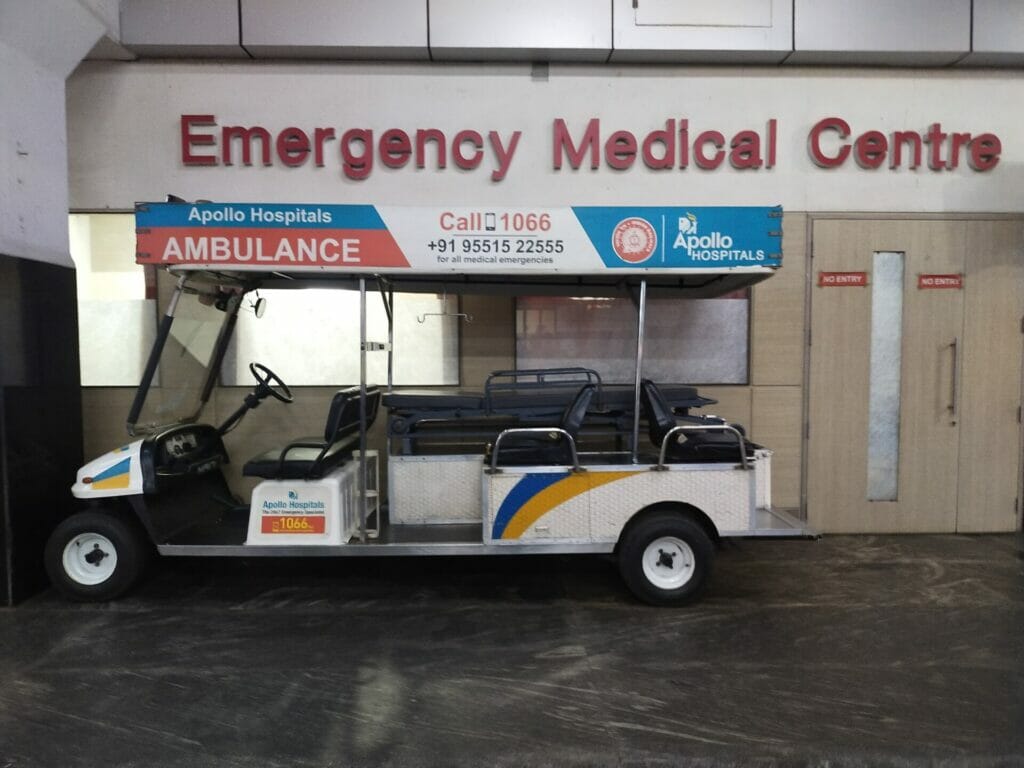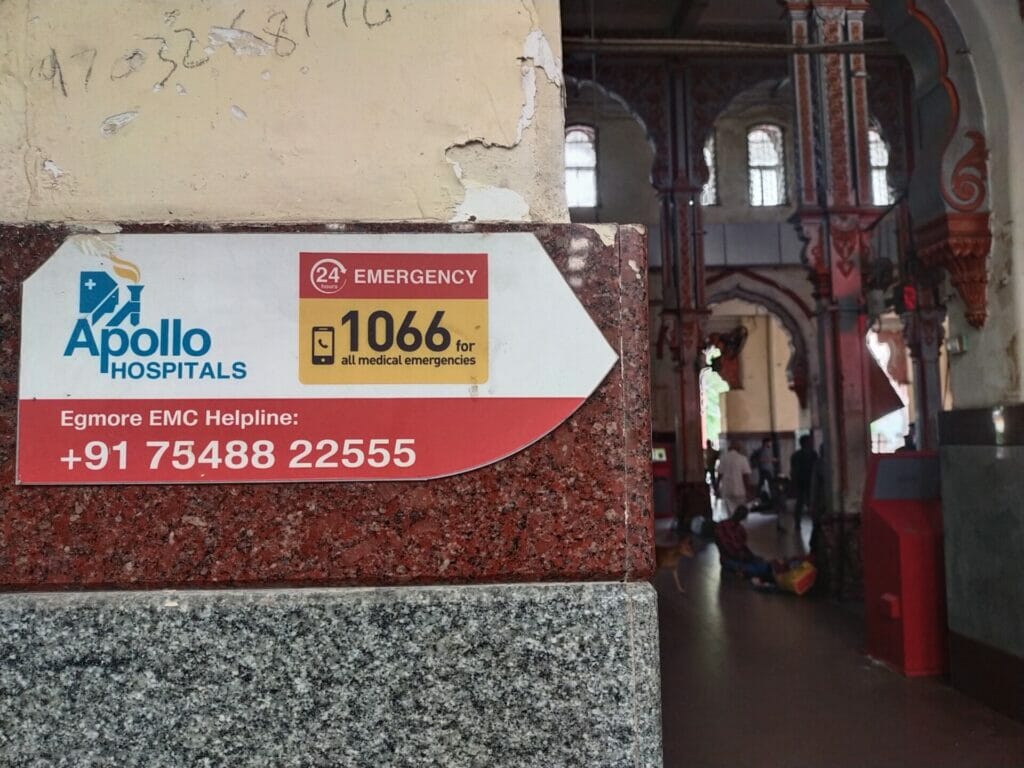Ramalingam*, a sexagenarian, was travelling alone from Madurai to Chennai on a Sunday morning and reached the Egmore railway station. As he was walking on the foot-over-bridge to take the metro rail, he went into a sudden cardiac arrest. While the public tried to help him and dial 108 ambulance service, not many were aware of the emergency medical centre inside the station’s premises that is exclusively meant for attending to medical emergency cases in Chennai Egmore railway station.
A railway staff noticed the crowd and intimated the medical staff at the centre. A female and a male nurse immediately rushed to the spot with the emergency equipment and other first aid materials. After a few minutes of Cardiopulmonary Resuscitation (CPR), Ramalingam was stabilised. He was then shifted to the emergency medical centre and later moved to the nearby government hospital for further treatment.
Had he not gotten the required medical attention during the golden hour, Ramalingam may not have survived the massive cardiac arrest, say paramedical staff. What came in handy during the incident was the availability of the paramedical staff at the spot.
Read more: A post-COVID travel experience by suburban rail in Chennai
Railway stations in Chennai, be it the main junctions like Egmore and Chennai Central or the Chennai Mass Rapid Transit System (MRTS) trains or the electric multiple units (EMU) trains plying between Tambaram and Beach, have a footfall of thousands of passengers on an everyday basis. These trains form a central point of connectivity to areas within the city and also to the suburbs.
Given such significance, it is pertinent to look into improving the availability of emergency medical services at these railway stations in Chennai.
What is an emergency medical centre?
The Southern Railways provides the land for free to corporate hospitals to set up round-the-clock emergency medical centres in the railway stations. The corporate hospitals in return set up a centre and provide medications free of cost to the passengers.

The private hospitals that win the tender to set up such centres deploy one doctor, three female paramedical staff, two male paramedical staff (round-the-clock duty), four housekeeping staff and two ambulance drivers in each centre. The hospitals also provide battery-charged ambulance buggies to ferry patients equipped to stabilize emergency cases arising at the stations in addition to an ambulance that can take the patients for further referrals. These centres provide primary health care services and have equipment to resuscitate like defibrillators, nebulisers, and stretchers. Each centre has a three-bedded facility and also has a stock of all the basic and emergency medicines.
Lack of awareness of medical emergency services in Chennai railway stations
Janny S, along with her friend, was rushing with luggage in both her hands to board a train at the Chennai Central railway station during a festival weekend. It was a rainy day. The station was more crowded than usual. As she tried to walk faster, she slipped and fell down. She ended up with a sprain in her leg and a hairline fracture in her hand. Neither she nor her friend knew if any emergency medical services were available at the railway station.
“Besides, as both of us knew only Hindi and English, we found it hard to ask for any assistance. We ended up taking an auto and going to the nearby government hospital,” says Jenny.
In yet another incident, Priya was in need of some medicines for fever and headache. As there was no pharmacy inside the Chennai Central Station, she had to take an auto to go in search of a pharmacy.

Many passengers that we talked to in the railway stations like Chennai Central and Egmore were unaware of the emergency medical centre set up inside the station’s premises.
According to the Southern Railways web portal, these centres have been in place in Chennai Central, Egmore and Tambaram stations since 2013. Yet, there are not many sign boards directing to the centres The helpline numbers too are not displayed in prominent places at these stations.
The passengers also found that the emergency medical centre in Chennai Central Station was not in a spot easily visible to the public.
According to the staff at the emergency medical centres, there is an average footfall of 15 to 20 patients at the centre in Egmore, while the centre in Chennai Central Station sees a footfall of 20 to 30 patients every day. The cases also go up during the festive season when there is more crowd. Seizures, cardiac arrest, headache, fever, body pain, leg pain, injuries due to slip and fall, and dressings for old wounds are some of the common cases that are seen at these centres.
“After providing the first-aid to the patients, the patients are given the choice to move to a private or a government hospital based on their medical condition. They will be taken to a government or a private hospital based on their choice,” says the staff.
However, while the ambulance service is free for patients who opt to go to a government hospital or to the private hospital that provides the service at the centre, the patients are charged when they opt to go to any other private hospital.
Further, the emergency medical centre in Egmore does not have a doctor. The staff nurse handles the cases and refers the patients to the hospitals for further treatment. Notably, the female nurse works on a 12-hour long shift, while the male nurse works on a 24-hour shift.
“It becomes challenging to handle the cases when there are many patients during the festive or holiday season. Otherwise, it is manageable,” says the staff.
They also noted that a pharmacy will soon be set up at the Chennai Central railway station.
Speaking on the challenges faced by the staff when they receive patients who do not speak Tamil or English, the staff also says that they will seek the help of some railway staff for translation when they have to communicate with the patients.
Numbers to reach out to for medical emergencies at railway stations
The general helpline for medical emergencies in railway stations is 138. According to the press release from the Indian Railways, “All India Helpline 138 receives calls for assistance for cleanliness, food and catering, coach maintenance, medical emergency and linen.”
This apart, the private hospitals that have set up emergency medical centres in the Chennai railway stations have also displayed their helpline number as shown in the picture above. Accordingly, passengers facing a medical emergency at Egmore station can contact +91 75488 22555, while those at Chennai Central can contact +91 95515 22555. They can also reach out to 1066 for all medical emergencies.
EMU and MRTS railway stations need medical centres

“Only when there is a facility in place, could there be a chance for improvement. Despite having a footfall of thousands of passengers in both EMU trains and the MRTS trains, these stations are not well equipped to handle medical emergency cases. The first-aid kits are said to be available in the room of the station masters but how will that alone be sufficient?,” asks V Rama Rao, a civic activist.
Read more: Why Chennai’s suburban rail passengers are struggling to get their voices heard
He further notes that the EMU and MRTS railway stations neither have lift or escalator facilities. Even when the ambulance arrives on time, a considerable amount of time will be wasted on carrying the patient over the stairs from one platform to another, especially given the significance of the golden hour.
When we enquired about the availability of medical assistance at the EMU and MRTS railway stations, the railway staff said that there is a first-aid kit at their stations. When asked how they will attend to medical emergencies that require more facilities than the first-aid kit, they said that they will call the 108 immediately.
“Even if it comes to doing CPR or doing a first-aid for a fracture, the public has more knowledge on such first responses than us,” they say.
Rama Rao demands that the EMU and MRTS stations should have primary medical facilities and at least one paramedical staff should be deployed there. “Even if not in all the stations, the railway’s department should consider making such facilities in at least three important stations in a given route. Facilities should also be made for communication between the stations so that the paramedical staff can travel from one station to another as and when required.”
Ways to improve emergency response
- Create more awareness of the available facilities
- Display the Helpline number on more visible spots
- Set up the emergency centres in visible spots
- Deploy more staff during festive/holiday seasons
- Establish such centres in both EMU and MRTS routes
*name changed on request
